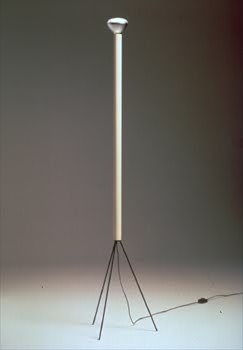Leading designer Achille Castiglioni was born on 26 February 1918; he died in Milan on 2 December 2002.
In 1997-1998, the MOMA in New York organized an important retrospective of the artist’s work, bringing together a large number of his objects and environments (room installations for trade fairs and museum). The exhibition can be visited virtually on the Museum’s website.
Born in Milan in 1918 and trained at its renowned Architectural Polytechnic, Castiglioni started out collaborating with his brother Pier Giacomo in an architectural studio. The brothers collaboration was very successful until Per Giacomo’s premature death in 1968.
The Castiglioni started out in the post-war years, when Italy was extremely poor and unable to undertake mayor architectural projects. Like many contemporaries, they turned to the design of interiors and functional objects for the home. An example is the Arco floor lamp, which takes its inspiration from a street lamp and projects light eight feet away from its base. Realized in stainless steel and balanced on a marble base, the lamp also demonstrates the designers’ attention to ‘noble’ long-lasting materials and high-quality industrial production.
Other objects designed by Castiglioni during this early period were almost ‘Dadaist’ in their conception and featured ‘found’ elements. An example is the stool Sella, where the use sits on a bike saddle balanced atop of a single thin leg. Seemingly impractical, the stool was nevertheless designed with functionality in mind: in Achille’s words, ‘when I use a pay phone, I like to move around, but I also would like to sit, but not completely.’ Rather than responding to the users’ needs, design is here nursing new needs and desires in its audience.
Castiglioni himself described objects such as Sella as ‘Ready-Made Objects,’ classifying them as a sub-family of his artistic production. Other creations were ‘Redesigned Objects,’ everyday objects updated to modern standards of technology and design, for example ashtrays and outdoor coffee tables such as the iconic Cumano. The ‘Minimalist Group’ contained the Luminator lamp, a light bulb on top of a narrow cylinder just wide enough to store the lamp’s plug and three spindly legs during transportation. Lastly, the designer also produced ‘Expressionistic Objects’ suggesting anthropomorphic or animal associations, like the stereo set RR 126.
Often commissioned by major furniture and home-ware brands such as Alessi, Flos and Driade, many of Castiglioni’s designs are still in production. Arco lamps, Firenze clocks and Caccia cutlery sets are still a common sight in many Italian homes, restaurants and shops.
References: Dario Schodeller, ‘CASTIGLIONI, Achille,’ Dizionario Biografico degli Italiani (2015); Paola Antonelli, ‘Curator’s Essay,’ Achille Castiglioni: Design!, MOMA website.
with Livio Castiglioni, Arco floor lamp, 1962, Carrara marble base, stainless steel stem, steel reflector, 95 x 78 5/8 x 11 ½”. Manufactured by Flos. New York: the Museum of Modern Art, gift of the manufacturer.
with Livio Castiglioni, Sella stool, 1983 (1957), leather, pink lacquered steel, and cast iron, 28 x 13″. Manufactured by Zanotta.
with Livio Castiglioni, Luminator floor lamp, 1994 (1955), steel, 51 ¼ x 6 x 6″. Manufactured by Gilardi & Barzaghi, Artform, and Flos.
Cumano table, 1979 (1977), steel, nylon, 21 5/8 x 44 ½ x 2 ¾”. Manufactured by Zanotta.
with Livio Castiglioni, RR 126 stereo system, 1965, plastic laminate, masonite, steel, 36 ¼ x 13 13/16 x 23 5/8″. Manufactured by Brionvega.
with Livio Castiglioni, Firenze wall clock, 1996 (1965), ABS plastic, 14 ¼ x 14 ¼”. Manufactured by Alessi.
with Luigi Castiglioni and Luigi Caccia Dominioni, Caccia cutlery set, 1990 (1938), 18/10 stainless steel and 925/00 silver. Manufactured by Alessi.







